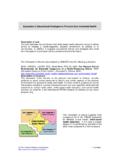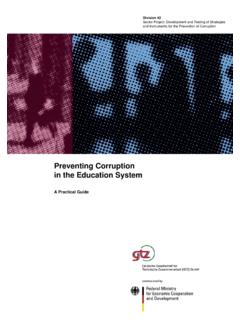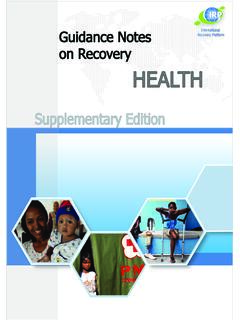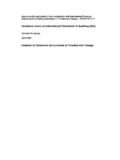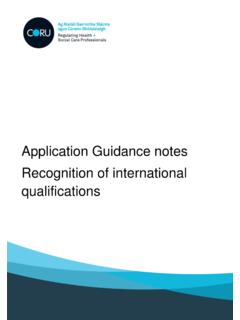Transcription of CONDUCTING CONFLICT ASSESSMENTS: …
1 DFIDD epartment forInternationalDevelopmentissuesCONDUCT INGCONFLICTASSESSMENTS: guidance NOTESC onducting CONFLICT Assessments: guidance NotesDFID2 AcronymsACRONYMSDFIDUK Department for international DevelopmentEUEuropean UnionGoSGovernment of SudanGoSLGovernment of Sri LankaGoUGovernment of UgandaICRCI nternational Committee of the Red CrossIDPI nternally Displaced Person IMFI nternational Monetary FundLRAL ords Resistance Army LTTEL iberation Tigers of Tamil Eelam NGONon-Governmental OrganisationSCAS trategic CONFLICT AssessmentSMES mall and Medium EnterprisesUNUnited NationsUNDPU nited Nations Development ProgrammeUNHCRU nited Nations High Commissioner for RefugeesDFIDC onducting CONFLICT Assessments: guidance Notes3 ContentsCONTENTSACRONYMS2 FOREWORD4 INTRODUCTION5 CONFLICT methodology ..6A flexible methodology ..7 Conceptual basis ..8 SECTION ONE: CONFLICT ..15 SECTION TWO: ANALYSIS OF international actors.
2 Between development interventions and THREE: DEVELOPING STRATEGIES AND common donor individual donor strategies ..26 ANNEX 1: GLOSSARY OF TERMS34 ANNEX 2: AN EXAMPLE OF A STRATEGIC CONFLICT ASSESSMENTREPORT37 ANNEX 3: EXAMPLE TERMS OF REFERENCE FOR A STRATEGICCONFLICT ASSESSMENT44 ANNEX 4: RESOURCES48 TABLEST able 1: CONFLICT Analysis10 Table 2: Examples of sources of tension and conflict12 Table 3: CONFLICT scenarios in Uganda17 Table 4: Analysis of international responses18 Table 5: Donor Government policy instruments & concerns in Sri Lanka20 Table 6: Strategies & options25 Table 7: Strategies & options in Sri Lanka30-33 BOXESBox 1: Local CONFLICT actors in the Ferghana Valley, Kyrgyzstan14 Box 2: CONFLICT triggers in Moldova16 Box 3: Example of the Interaction between latent CONFLICT and a development programme in Kyrgyzstan24 CONDUCTING CONFLICT Assessments: guidance NotesDFID4 ForewordFOREWORDThis booklet aims to provide staff at the Department for international Development(DFID) and partner bilateral and multilateral agencies with a resource to help: analyse CONFLICT ; better assess CONFLICT related risks associated with development or humanitarianassistance; and develop options for more CONFLICT sensitive policies and programmes.
3 A methodology is presented for CONFLICT assessment at the country or regional level,termed Strategic CONFLICT assessment . It is based on DFID s experience in conductingStrategic CONFLICT Assessments in seven countries. A separate synthesis report,summarising findings of these assessments, is also available from DFID. The principal authors of these guidance notes are Jonathan Goodhand, Tony Vaux andRobert Walker. Many people provided advice and support during the course of thiswork and it is not possible to mention them all. However special thanks are due to thefollowing: Debi Duncan who was responsible for leading the project within DFID andwho provided vital support throughout the process; Jo Boyden, Mark Hoffman, PeterOakely, Brian Pratt and Michael Warner who were involved in the advisory group andcommented on earlier drafts of this KapilaDr Mukesh KapilaHead, CONFLICT and Humanitarian Affairs DepartmentDFIDJ anuary 2002 DFIDC onducting CONFLICT Assessments: guidance Notes5 IntroductionINTRODUCTIONCONFLICT ASSESSMENTThe objective of CONDUCTING CONFLICT assessments is to improve the effectiveness ofdevelopment policy and programmes in contributing to CONFLICT prevention andreduction.
4 CONFLICT assessments can be used to assess: risks of negative effects of CONFLICT on programmes; risks of programmes or policies exacerbating CONFLICT ; opportunities to improve the effectiveness of development interventions incontributing to CONFLICT prevention and assessment can focus on individual projects and programmes or at a strategiclevel to focus on a country or region. Strategic CONFLICT assessments have now beenconducted by DFID in seven countries. In each country, the approach has been to mapout the CONFLICT and current responses to it and to identify future policy and programmeoptions. CONDUCTING a country level CONFLICT assessment has been a valuable means ofdeveloping more strategic approaches for contributing to CONFLICT reduction, incollaboration with other actors. The accompanying booklet to this guide, CONDUCTING CONFLICT Assessments: AnIntroduction , sets out the background to DFID s CONFLICT assessment work.
5 It considersthe links between poverty and CONFLICT , the role of CONFLICT assessments and when DFIDmay consider CONDUCTING them. This guide describes in more detail the methodologythat has been used in the CONFLICT assessments. CONDUCTING CONFLICT Assessments: guidance NotesDFID6 IntroductionTHE METHODOLOGYT here have been 3 key stages in the strategic CONFLICT assessments conducted by DFIDto date: 1. Analysis of the conflict2. Analysis of international responses to the conflict3. Development of strategies and optionsSections 1 to 3 of this guide describe the methodology for each of these stages. Theapproach is summarized below. THE THREE KEY STAGES OF CONFLICT ASSESSMENTThe purpose of CONDUCTING the assessments has been to develop a strategy for DFID,working with other organisations, to better respond to a particular CONFLICT immediate output in each case has been a Strategic CONFLICT assessment Report,(SCA).
6 An example of an SCA Report is presented in summary form in Annex AConflict AnalysisAnalysis of: Structures Actors DynamicsStage BAnalysis of Responses Mapping externalresponses Mappingdevelopmentpolicies andprogrammes Assessing impactson CONFLICT andpeaceStage CStrategies/Options Influencing otherresponses to CONFLICT Developing/refiningDFID policy andprogrammeapproachesDFIDC onducting CONFLICT Assessments: guidance Notes7 IntroductionA FLEXIBLE METHODOLOGYThe methodology in the following sections presents guiding principles for conductingan SCA. It should not be viewed as a standardised formula: Adapt according to the needs and objectives of the end conflictassessments may have limited value if they are not linked to the capacities and needsof the end user. CONFLICT assessments should be customised according to the particularactivities of an individual donor for example is it being conducted for early warningand preventative action, ongoing monitoring, impact assessment , or sectoralprogramming?
7 Develop according to the nature and phase of the value of conflictanalysis from a development donor perspective is likely to vary according to (1) thephase of the CONFLICT and (2) the capacity of donors to influence the trajectory of theconflict. Where the CONFLICT is still at an early stage; and where aid donors aresignificant actors with some leverage over the conflicting parties, a rigorous conflictanalysis could help aid donors work on CONFLICT . However, where violent CONFLICT hasbecome protracted and aid resources are relatively insignificant, CONFLICT assessmentmay be most useful in terms of assisting aid donors to be more sensitive to conflictdynamics and enabling them to work more effectively in CONFLICT . Develop dynamic forms of the standard contextual analysis foundin donor country profiles focuses on structural factors, CONFLICT analysis should involvea more dynamic profiling of a context with a particular focus on actors, incentivesand triggers for violent CONFLICT .
8 The added value lies less in the information gatheringthan in the analysis, interpretation and prediction of CONFLICT trends. This is not an exactscience and never will be there is no substitute for skilled regional specialists andanalysts. One should also be realistic about its predictive powers; at best it is aboutidentifying plausible joined-up analysis is done by different actors and atdifferent locations and levels within the aid system, it rarely seems to reach the rightplaces to influence policy and practice. In Sri Lanka for instance, a range ofdevelopment and non development actors have conducted CONFLICT analysis, but thishas not led to a shared analysis amongst the international community or commonstrategies in response to the CONFLICT . Shared analysis is therefore a prerequisite for thedevelopment of coherent CONFLICT Assessments: guidance NotesDFID8 IntroductionCONCEPTUAL BASIS Most conflicts and protracted political crises today do not occur between sovereignstates but are of an internal or regionalised type.
9 Of the 27 major armed conflicts thatoccurred in 1999, all but two took place within national boundaries (Collier, 2000) are a number of different theoretical frameworks for analysing contemporaryconflicts. This guide is based upon a multidisciplinary approach which uses a numberof different analytical lenses to examine and develop responses to violent CONFLICT . Important recent advances in the understanding of CONFLICT come from the political economy approach. This focuses on the political and economicinterests of those engaged in CONFLICT and draws attention to those who mightsee an advantage in using CONFLICT for their own ends. If the political economyof war brings opportunities, there will be strong interests in perpetuating andmanaging war for purposes of personal gain. Interventions which ignore theseinterests risk fuelling the CONFLICT .
10 The above approach has been developed into an analysis of the causes of warin terms of greed (meaning opportunities for predatory accumulation) and grievance (meaning the negative reactions of those who are disadvantaged) the greed and grievance framework usefully highlights economic agendasin war, it is only one of a number of ways of looking at CONFLICT and should becomplemented by other analytical lens, in particular social, anthropologicaland gender analysis. Comprehensive CONFLICT analysis should combine an analysis of structures andactorsand how the two interact with one another. Structural analysis focuses onthe institutions (political, economic, social and military) which may predisposea country to violent CONFLICT . Actor oriented analysis involves a fine grained analysis of individual incentives and motivations. conflicts are aboutperceptions and the meanings that people attribute to events, institutions,policies and appeals for public support.

